Wedding dress
A wedding dress or bridal gown is the dress worn by the bride during a wedding ceremony. The color, style and ceremonial importance of the gown can depend on the religion and culture of the wedding participants. In Western cultures, the wedding dress is most commonly white, which fashion was made popular by Queen Victoria when she married in 1840. In eastern cultures, brides often choose red to symbolize auspiciousness.

| Part of a series on |
| Western dress codes and corresponding attires |
|---|
|
|
|
Casual (anything not above) |
|
Supplementary alternatives
|
|
Legend: |
Western culture
_LACMA_M.70.90a-b.jpg)
Weddings performed during and immediately following the Middle Ages were often more than just a union between two people. They could be a union between two families, two businesses or even two countries. Many weddings were more a matter of politics than love, particularly among the nobility and the higher social classes. Brides were therefore expected to dress in a manner that cast their families in the most favorable light and befitted their social status, for they were not representing only themselves during the ceremony. Brides from wealthy families often wore rich colors and exclusive fabrics. It was common to see them wearing bold colors and layers of furs, velvet and silk. Brides dressed in the height of current fashion, with the richest materials their families' money could buy. The poorest of brides wore their best church dress on their wedding day. The amount and the price of material a wedding dress contained was a reflection of the bride's social standing and indicated the extent of the family's wealth to wedding guests.
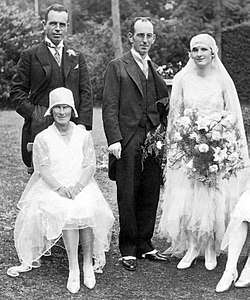
Color of wedding dresses
The first documented instance of a princess who wore a white wedding dress for a royal wedding ceremony is that of Philippa of England, who wore a tunic with a cloak in white silk bordered with squirrel and ermine in 1406, when she married Eric of Pomerania.[1][2] Mary, Queen of Scots, wore a white wedding dress in 1559 when she married her first husband, Francis, the Dauphin of France, because it was her favorite color, although white was then the color of mourning for French Queens.[3][4]
This was not a widespread trend, however: prior to the Victorian era, a bride was married in any color, black being especially popular in Scandinavia.[5]
White became a popular option in 1840, after the marriage of Queen Victoria to Albert of Saxe-Coburg, when Victoria wore a white gown trimmed with Honiton lace. Illustrations of the wedding were widely published, and many brides opted for white in accordance with the Queen's choice.[6]
Even after that, for a period, wedding dresses were adapted to the styles of the day. In the early 1900s, clothing included a lot of decorations, such as lace or frills. This was also adopted in wedding dresses, where decorative frills and lace was common. For example, in the 1920s, they were typically short in the front with a longer train in the back and were worn with cloche-style wedding veils. This tendency to follow current fashions continued until the late 1960s, when it became popular to revert to long, full-skirted designs reminiscent of the Victorian era.
Today, Western wedding dresses are usually white,[7] though "wedding white" includes shades such as eggshell, ecru and ivory.
Later, many people assumed that the color white was intended to symbolize virginity, though this was not the original intention: it was the color blue that was connected to purity, piety, faithfulness, and the Virgin Mary.[8]
White is not the universal colour of wedding dresses. In Mexico, for example, red is a popular colour.
Current fashion

Today, about 75% of wedding dresses on the market are sleeveless and strapless, though some brides may prefer more modest styles with sleeves, higher necklines, and covered backs. Most of today's wedding dresses have either lace-up backs or zipper backs. Wedding dresses can also be long or short, depending on the type of wedding.
Silhouettes
Some of the most popular contemporary silhouettes include: A-line, ballgown, empire, mermaid, tea-length, and trumpet.
- A-line
- A dress or skirt silhouette that is narrower at the top, flaring gently wider toward the bottom thereby resembling the letter A. Works well on most figure types; good for disguising bottom-heavy figures.
- Ballgown
- Characterized by a very full skirt that begins at the waist and continues to floor length. It has a full bodice and a cinched waistline that falls into a full skirt.
- Empire
- A type of dress or top where the waist line is raised above the natural waistline, sometimes as high as right below the bust.
- Mermaid
- The mermaid dress is close fitting through the bodice, down through the hips and to below the knees where the skirt flares out.
- Mini
- A dress with a hemline that hits the center of the thigh.
- Tea-length
- Can resemble a cocktail-style dress that shows off the lower legs and bridal shoes.
- Trumpet
- A straight skirt with a hem flounce that flares away from the body at the hem.
Necklines
Popular contemporary necklines types include: asymmetric, bateau, halter, jewel, off-the-shoulder, portrait, scoop, sheer, square, strapless, sweetheart, and v-neck. The neckline refers to the shape of the material at the top of the dress as it falls on the neck and shoulders.
- Asymmetric
- Asymmetrical by its very definition means there is no symmetry or no balance. So this neckline appears different on either side of the centre front.
- Bateau
- Also known as the "Boatneck". This is a wide, high neckline that follows the curve of the collarbone and ends in points on the shoulder seams.[9]
- Halter
- Necklines have a high panel on the front, which is then tied around the neck for support and, optionally, may be tied behind the neck or include a clasp, exposing the back and shoulders.[10]
- Jewel
- A plain, slightly rounded neckline without a collar.[11] Also known as the T-shirt neckline, the jewel neckline is round and sits at the base of the throat.
- Off-the-shoulder
- This neckline sits below the shoulders, with sleeve-like straps that cover part of the upper arm. Shows off your collarbone and shoulders.
- Portrait
- Characterised by a wide, soft scoop from shoulder to shoulder.
- Scoop
- Also known as a "ballerina neckline", this U-shaped style is often cut low, and occasionally the scoop will continue on the back of the dress.
- Sheer
- A neckline that is created by "sheer" or translucent fabric, such as lace or netting, rather than an opaque material or strap.
- Spaghetti strap
- This neckline is nearly strapless, except for the presence of thin, delicate straps; a bit like strings of spaghetti.
- Square
- The neckline is cut straight across the top in between the straps, creating a "square"-like shape to the top of the dress.
- Strapless
- A neckline that can be any shape, but is discerned by its lack of straps (neither over the shoulder, nor around the neck).
- Sweetheart
- A neckline with a plunge in the front in the shape of the top of a heart.
- V-neck
- A neckline characterized by a plunge in the front shaped like the letter "V".
Gown length
- Ankle
- Characterized by a hemline that hits at the ankle.
- Floor
- Characterized by a hemline that hits the floor.
- Mini
- Characterized by a hemline that hits the center of the thigh.
- Tea
- Characterized by a skirt length that falls between the knee and ankle.
- Train
- Characterized by a skirt length or attached and/or detachable train that can be several feet long.
Eastern culture
Many wedding dresses in China, India (wedding sari), Pakistan (heavily embroidered shalwar qameez or lehngas) are red; the traditional colour representing good luck and auspiciousness. Vietnam wedding dresses (in the traditional form of áo tấc the ancient Ao dai) were blue, dark blue.
Nowadays, many women choose other colours besides red. In modern mainland Chinese weddings, the bride may opt for Western dresses of any colour, and don a traditional costume for the wedding tea ceremony.
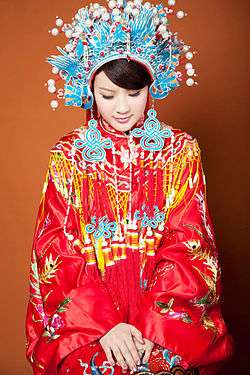
In modern Taiwanese weddings, the bride generally picks red (following Chinese tradition) or white (more Western) silk for the wedding gown material, but most will wear the red traditional garment for their formal wedding banquets. Traditionally, the father of the bride is responsible for the wedding banquet hosted on the bride's side and the alcohol (specifically called "xi-jiu," confusingly the same as what the wedding banquet itself is called) consumed during both banquets. While the wedding itself is often based on the couple's choices, the wedding banquets are a symbolic gesture of "thanks" and appreciation, to those that have raised the bride and groom (such as grandparents and uncles) and those who will continue to be there to help the bride and groom in the future. Thus out of respect for the elders, wedding banquets are usually done formally and traditionally.
Red wedding saris are the traditional garment choice for brides in Indian culture. Sari fabric is also traditionally silk. Over time, colour options and fabric choices for Indian brides have expanded. Today fabrics like crepe, Georgette, charmeuse, and satin are used, and colors have been expanded to include gold, pink, orange, maroon, brown, and yellow as well. Indian brides in Western countries often wear the sari at the wedding ceremony and change into traditional Indian wear afterwards (lehnga, choli, etc.).
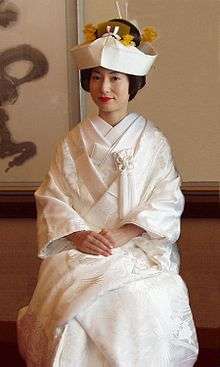
A Japanese wedding usually involves a traditional pure white kimono for the formal ceremony, symbolizing purity and maidenhood. The bride may change into a red kimono for the events after the ceremony for good luck.
The Javanese people of Indonesia wear a kebaya, a traditional kind of blouse, along with batik.
In the Philippines, variations of the Baro't saya adapted to the white wedding tradition are considered to be wedding attire for women, along with the Barong Tagalog for men. Various tribes and Muslim Filipinos don other forms of traditional dress during their respective ceremonies.
Native American culture

The indigenous peoples of the Americas have varying traditions related to weddings and thus wedding dresses. A Hopi bride traditionally had her garments woven by the groom and any men in the village who wished to participate. The garments consisted of a large belt, two all-white wedding robes, a white wedding robe with red stripes at top and bottom, white buckskin leggings and moccasins, a string for tying the hair, and a reed mat in which to wrap the outfit. This outfit also served as a shroud, since these garments would be necessary for the trip through the underworld.
A Pueblo bride wore a cotton garment tied above the right shoulder, secured with a belt around the waist.
In the traditions of the Delaware, a bride wore a knee-length skirt of deerskin and a band of wampum beads around her forehead. Except for fine beads or shell necklaces, the body was bare from the waist up. If it was a winter wedding, she wore deerskin leggings and moccasins and a robe of turkey feathers. Her face was painted with white, red and yellow clay.
The tribes of Northern California (which include the Klamath, the Modoc and the Yurok) had a traditional bridal dress woven in symbolic colors: white for the east, blue for the south, yellow (orange) for the west; and black for the north. Turquoise and silver jewelry were worn by both the bride and the groom in addition to a silver concho belt. Jewelry was considered a shield against evils including hunger, poverty and bad luck.
Gallery
Historical European wedding dresses
 Detail from The Marriage by Nicolo da Bologna, 1350s.
Detail from The Marriage by Nicolo da Bologna, 1350s. Helena Fourment, second wife of Peter Paul Rubens, painted by Rubens in her wedding dress, 1630.
Helena Fourment, second wife of Peter Paul Rubens, painted by Rubens in her wedding dress, 1630. Sophia Magdalena of Denmark's wedding dress, 1766. The Royal Armoury in Sweden.
Sophia Magdalena of Denmark's wedding dress, 1766. The Royal Armoury in Sweden. Marriage of Napoleon I and Marie Louise. France, 1810.
Marriage of Napoleon I and Marie Louise. France, 1810.
Wedding dresses from different areas of the world
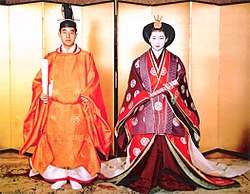 Traditional Japanese wedding robes worn by the Crown Prince of Japan, Akihito and Michiko Shoda for their marriage, 1959.
Traditional Japanese wedding robes worn by the Crown Prince of Japan, Akihito and Michiko Shoda for their marriage, 1959. Wishram (North American Indian) bride around 1911
Wishram (North American Indian) bride around 1911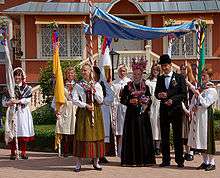 Traditional Finnish farmer wedding dress in Jomala
Traditional Finnish farmer wedding dress in Jomala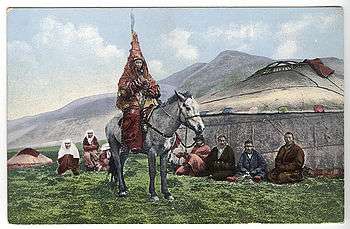 Traditional Kazakh wedding dress
Traditional Kazakh wedding dress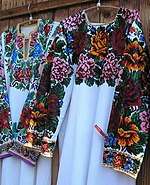 Hutsul wedding dress
Hutsul wedding dress Traditional Armenian wedding dress
Traditional Armenian wedding dress Bride in a wedding dress, Podhale, the Tatra Mountains
Bride in a wedding dress, Podhale, the Tatra Mountains
Middle Eastern dresses
 Jewish Yemenite bride in Israel, 1950's
Jewish Yemenite bride in Israel, 1950's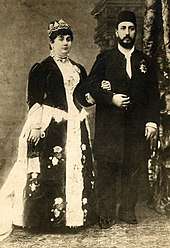 Wedding of Tewfik Pasha and Emina Ilhamy, Cairo, Egypt, January 1873
Wedding of Tewfik Pasha and Emina Ilhamy, Cairo, Egypt, January 1873
East Asian dresses
 Chinese couple wearing traditional wedding hanfu
Chinese couple wearing traditional wedding hanfu- Reenactment of the royal wedding ceremony of King Gojong and Queen Myeongseong
South Asian dresses
 Indian Hindu bride in red Sari
Indian Hindu bride in red Sari West Bengali bride
West Bengali bride Indian Christian bride in white Sari
Indian Christian bride in white Sari Bangladeshi bride in formal matrimonial Sari
Bangladeshi bride in formal matrimonial Sari Bride at a Nikah ceremony wearing typical South Asian red head covering and jewellery
Bride at a Nikah ceremony wearing typical South Asian red head covering and jewellery A Nepali bride in wedding dress
A Nepali bride in wedding dress Nepali bride of Kathmandu, 1941
Nepali bride of Kathmandu, 1941
Modern Western-style dresses
 A bride in 1968, wearing a dress reflecting the styles of the time
A bride in 1968, wearing a dress reflecting the styles of the time Taiwanese couple dressed Western-style for keepsake photos in the park, 1989
Taiwanese couple dressed Western-style for keepsake photos in the park, 1989 Opulent wedding dress of Soraya Esfandiary, created by Christian Dior
Opulent wedding dress of Soraya Esfandiary, created by Christian Dior Patricia Nixon Cox with her father Richard Nixon, 1971
Patricia Nixon Cox with her father Richard Nixon, 1971 American bride marrying a Scotsman wearing a kilt, 1996
American bride marrying a Scotsman wearing a kilt, 1996 New Orleans bride wearing a strapless, sleeveless gown, 2006
New Orleans bride wearing a strapless, sleeveless gown, 2006
See also
- Wedding dress of Lady Diana Spencer
- Wedding dress of Sarah Ferguson
- Wedding dress of Kate Middleton
- Wedding dress of Meghan Markle
- Wedding dress of Queen Victoria
- Wedding dress of Jacqueline Bouvier
- Wedding dress of Grace Kelly
- Wedding dress of Wallis Warfield
- Wedding dress of Princess Elizabeth
- Wedding dress of Princess Margaret
- Wedding dress of Camilla Parker Bowles
- Wedding dress of Princess Mary of Teck
- Wedding dress of Princess Anne
- Wedding dress of Princess Alexandra of Denmark
- Wedding dress of Sophie Rhys-Jones
- Wedding dress of Victoria, Princess Royal
References
| Wikimedia Commons has media related to Wedding dress. |
- "Wedding white doesn't mean what you think it means". Ivy Bridal Studio. 3 March 2014. Archived from the original on 11 May 2016. Retrieved 21 November 2014.
Princess Philippa of England is the first recorded princess to have worn white during her wedding in 1406, with her attire consisting of a tunic and cloak in white silk, but it wasn’t until Queen Mary that the white dress would explode in popularity
- "The History of Matrimony". Amalfi Wedding Planner. Archived from the original on 6 May 2006.
- "Mary, Queen of Scots' first wedding day". Madame Guillotine. 24 April 2011. Archived from the original on 23 June 2015. Retrieved 21 November 2014.
Mary’s choice of a white wedding dress was an unusual one, particularly as white was more traditionally worn by royal ladies when they were in dieul blanc mourning but in this as in other things the strong willed Mary may well have been an innovator, keen to not just impress her own taste on her wedding day (after all, she hadn’t been allowed the privilege of choosing her groom) but also emphasise her virginity and show off her famously pale redheaded beauty, which would have been accentuated by a pure white dress.
- "Elizabeth I Facts". The Elizabeth Files. Archived from the original on 24 July 2018. Retrieved 21 November 2014.
Her favourite dress colours were white and black which symbolised purity.
- Pelo, June. "Old Marriage Customs in Finland". Sydaby.eget.net. Retrieved 19 January 2019.
- "Royal Weddings 1840-1947". Royal Collection Trust. Retrieved 19 January 2019.
- Stewart, Jude (14 February 2011). "The Bride Wore Chartreuse: Why (Most) Wedding Dresses are White". Print. Retrieved 19 January 2019.
- Ashliman, DL (2004). Folk and Fairy Tales: A Handbook–Greenwood Folklore Handbooks. ABC-CLIO. p. 9. ISBN 9780313058592.
- "Bateau neckline | Define Bateau neckline at Dictionary.com". Dictionary.reference.com. Retrieved 2010-09-08.
- "Catwalking / glossary". Catwalking.com. Archived from the original on 2011-11-07. Retrieved 2010-09-08.
- "jewel neck - Definition of jewel neck at". Yourdictionary.com. 2010-08-10. Retrieved 2010-09-08.
External links
| Wikimedia Commons has media related to Wedding dress. |
- Fashion Plates of Wedding Dresses from 1820-1929 from The Metropolitan Museum of Art Libraries
- Wedding Dresses at Chicago History Museum Digital Collections
- Wedding dress, 1900, in the Staten Island Historical Society Online Collections Database
- Wedding dress, 1951, in the Staten Island Historical Society Online Collections Database
